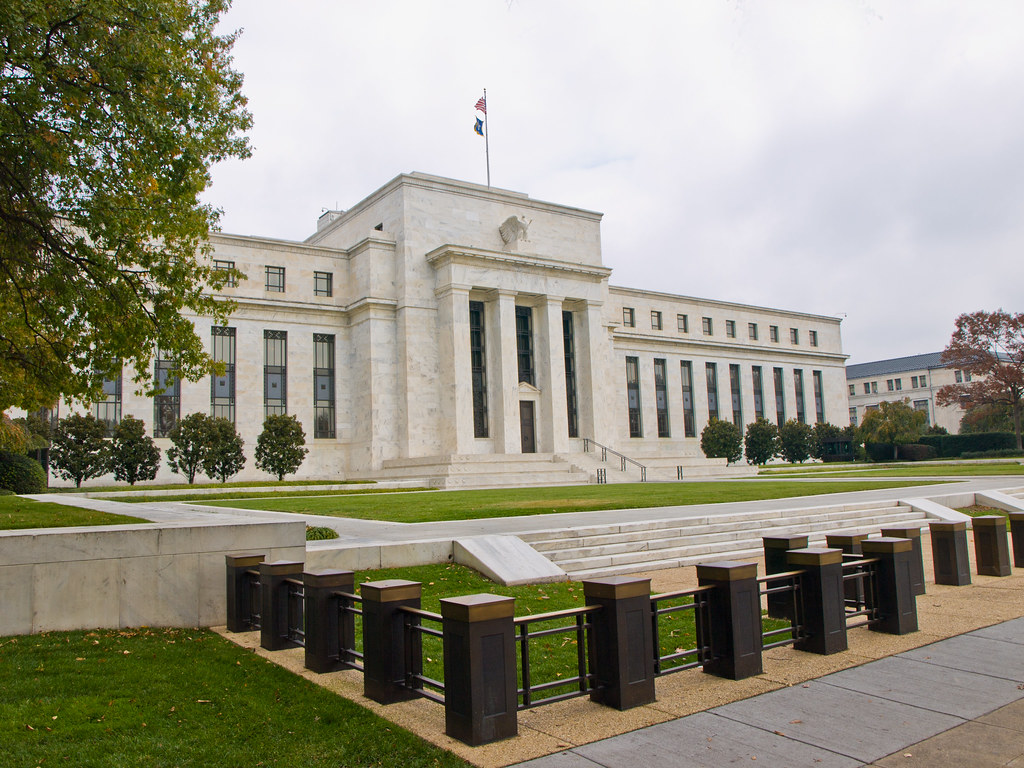Main Points :
- The U.S. Federal Reserve (FRB) reduced interest rates by 0.5%, a significant move that could impact cryptocurrency markets.
- Market participants anticipated the rate cut, leading to short-term market volatility.
- Bitcoin (BTC) and other risk assets initially rose but saw profit-taking afterward.
- The U.S. economic outlook remains uncertain, with inflation and employment risks still present.
- Long-term, the rate cut and U.S. election could influence Bitcoin’s price trajectory, with potential upward momentum from ETF approval and Bitcoin’s halving event.
Rate Cut and Its Potential Influence on Cryptocurrencies
On September 18, 2024, the U.S. Federal Reserve (FRB) made a monumental decision during its Federal Open Market Committee (FOMC) meeting to lower the Federal Funds Rate by 0.5 percentage points, bringing it to a target range of 4.75%–5%. This sharp rate reduction was the first of its kind since March 2020 and signals a shift in monetary policy aimed at managing economic challenges. The central question among investors is how this decision will affect the cryptocurrency markets, particularly Bitcoin (BTC), which has historically reacted strongly to U.S. monetary policies.
What Led to the Rate Cut?
The decision by the FRB came after several months of economic uncertainty, with inflationary pressures and concerns over employment playing a key role. During the FOMC meeting, FRB officials stated their increasing confidence that inflation would continue moving toward their 2% target, which allowed them to take a more aggressive stance with a 0.5% rate cut.
While inflation has moderated, the economic outlook remains fragile, with participants expressing concern about potential risks to employment and inflation goals. The U.S. Consumer Price Index (CPI) report for August 2024 initially led to expectations of a smaller 0.25% rate cut, but reports from financial institutions like The Wall Street Journal and Financial Times pointed to the possibility of a larger cut, which was eventually realized.
Immediate Market Reactions: Cryptocurrencies and Risk Assets
In the hours following the announcement, financial markets experienced sharp movements. Both the New York Stock Exchange and the Nasdaq Composite saw brief gains before reverting to lower levels, reflecting a wave of profit-taking as investors processed the implications of the rate cut. Cryptocurrency markets, led by Bitcoin, mirrored these trends.
Bitcoin briefly climbed past $60,000 before falling to approximately $60,231 at the time of writing, reflecting a 0.2% decrease from the previous day. This pattern suggests that while the rate cut was expected, it had already been priced in by the market, leading to short-term volatility as traders locked in profits.
Subdued Optimism for Cryptocurrencies
For Bitcoin and other digital assets, lower interest rates often act as a tailwind. When the cost of borrowing decreases, liquidity flows into riskier assets, including cryptocurrencies. However, in this case, the 0.5% rate cut appears to have had a muted effect on Bitcoin’s price. Some analysts attribute this to the fact that market participants had already anticipated the cut, and the news was largely factored into prices beforehand.
Additionally, rising U.S. Treasury yields may have also dampened enthusiasm for risk assets, including cryptocurrencies. The increase in yields suggests that investors are still uncertain about the long-term economic outlook and could remain cautious in allocating capital to digital assets until the economic picture becomes clearer.
Long-Term Implications: Will Bitcoin Benefit from the Rate Cut?
Despite the initial tepid market response, there are reasons to believe that Bitcoin could benefit from the Federal Reserve’s rate cut in the medium to long term. Historically, Bitcoin has thrived in environments with abundant liquidity, and if the Federal Reserve continues on this path of monetary easing, it could lay the groundwork for future gains.
Furthermore, upcoming events in the cryptocurrency ecosystem, such as the anticipated approval of a spot Bitcoin exchange-traded fund (ETF) and Bitcoin’s next halving event, may provide additional catalysts for upward price movement.
Key Economic Indicators to Watch
Investors in both traditional and crypto markets should continue to monitor U.S. economic data, as it will likely dictate the Federal Reserve’s future policy decisions. Two key indicators are inflation and employment. Although the Fed has expressed confidence in its ability to manage inflation, employment remains a more significant concern.
The Federal Reserve’s economic projections suggest that the U.S. unemployment rate will rise to 4.4% by the end of 2024, up from 4.0% earlier this year. While this increase is not dramatic, any significant deterioration in labor market conditions could prompt further monetary easing, which may support higher prices for cryptocurrencies.
The Global Impact: Other Influential Factors
Beyond the U.S., other global developments will also shape the trajectory of cryptocurrency markets. In particular, the upcoming U.S. presidential election is a critical factor to watch. Historically, political uncertainty has driven volatility in financial markets, and this election cycle could be no exception.
In addition, global geopolitical tensions, particularly in the Middle East, could impact oil prices and, by extension, global economic growth. Any significant slowdown could prompt central banks around the world, including the Federal Reserve, to adopt more accommodative policies, providing additional support for cryptocurrencies.
Japan’s Monetary Policy and Its Influence
In Japan, the Bank of Japan (BOJ) is also expected to play a pivotal role in global financial markets. The BOJ’s monetary policy decisions, particularly regarding negative interest rates, could influence capital flows into cryptocurrencies. As Japan remains one of the largest cryptocurrency markets in the world, any policy shift there could have ripple effects on Bitcoin and other digital assets.
The Path Ahead for Bitcoin: A Perfect Storm?
In the near term, the U.S. rate cut might not provide an immediate boost to cryptocurrency markets, but it sets the stage for a potentially explosive rally in the future. Bitcoin’s price movements will likely depend on a confluence of factors, including the approval of a spot ETF, the upcoming halving event, and broader macroeconomic conditions.
Investors should closely watch the Federal Reserve’s November and December meetings, as they may provide additional clues about the future direction of monetary policy. If the Federal Reserve continues to reduce rates, it could serve as a tailwind for Bitcoin and other cryptocurrencies heading into 2025.

A Time of Uncertainty, But Potential Opportunity
The Federal Reserve’s 0.5% rate cut marks a significant moment for global financial markets. While the immediate reaction from cryptocurrencies has been muted, the long-term outlook remains more optimistic. Bitcoin, in particular, could stand to benefit from a combination of easing monetary policy and key developments within the crypto space, including the potential approval of a spot ETF and its 2024 halving event.
In conclusion, although market participants should brace for short-term volatility, the Federal Reserve’s decision to cut rates could ultimately provide the backdrop for a new bull run in cryptocurrencies, making this a pivotal moment for investors.


